7 Easy Stretches You Can Do at Your Desk Chair

If your profession involves hunching over a computer for eight hours per day, it’s perhaps no wonder that you—like so many Americans—find your job to be a royal pain in the back. In fact, a 2021 study tracked data from 2,000 subjects who worked on computers and found that 48 percent experienced neck and back pain. “Over time, this can result in chronic pain, a decreased range of motion, and even tension headaches,” explains Andrew White, CPT, a personal trainer and the owner of Garage Gym Pro. The good news? There are several easy stretches you can do right at your desk chair.
To learn how to ward off pain and discomfort during the workday and beyond, read on to learn which eight stretches you can do while seated to help cure your “online spine” and other ailments.
RELATED: 8 Ways to Motivate Yourself to Take a Daily Walk.
7 Easy Stretches You Can Do at Your Desk
1. Neck and shoulder stretch
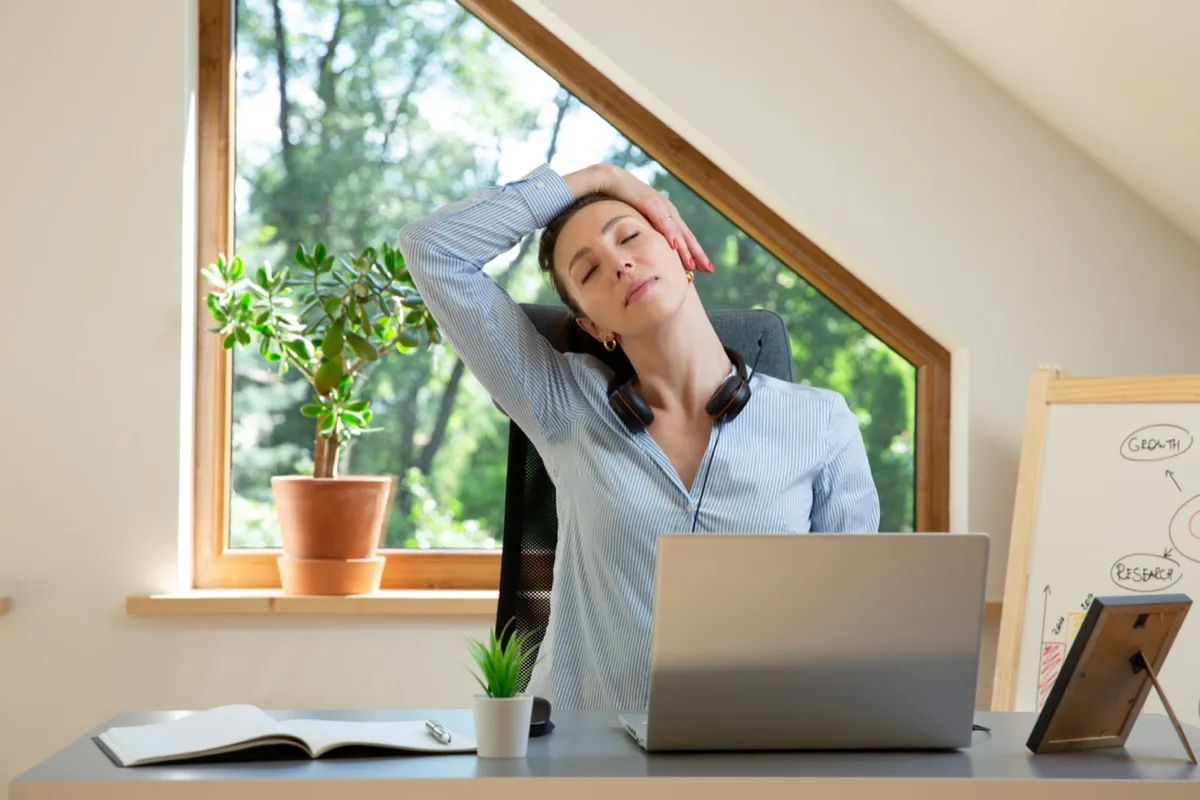
Stretches that relax your neck and shoulders are a great place to begin since these are areas of your body that accumulate the most tension during the workday, says White.
“Sit up straight in your chair and gently tilt your right ear towards your right shoulder. Extend your left arm down and to the side to deepen the stretch along the left side of your neck and shoulder. Hold this for about 20 seconds and then switch sides,” he suggests.
“Regularly performing this stretch helps to lengthen the muscles, release tension, and increase blood flow to the area, reducing discomfort and increasing overall well-being,” White adds.
Dazmyn Faris, training coordinator at StretchLab, adds that to increase the intensity, you can either gently place your right hand on the side of your head to guide your neck deeper into the stretch, or place your left hand under your desk chair to anchor down the stretch.
2. Overhead arm pull
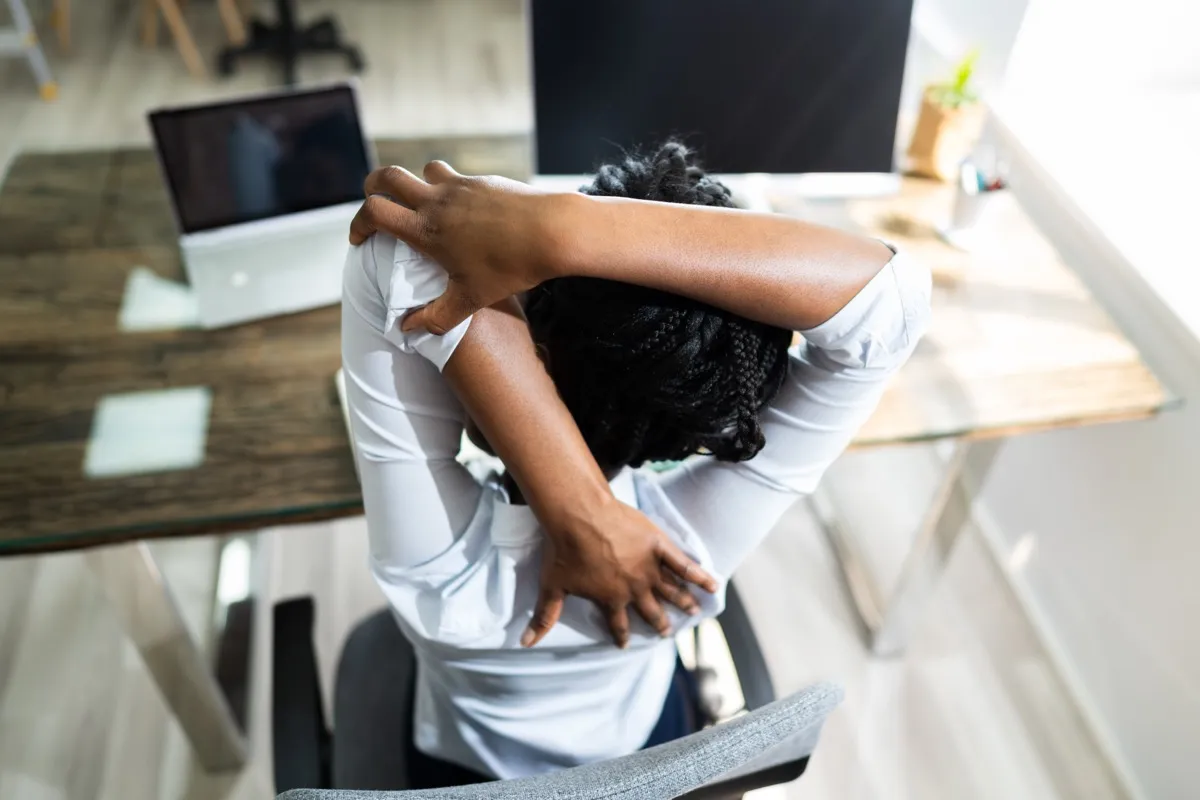
Another simple stretch that can improve your flexibility and release tension is the overhead arm pull. Josh York, founder and CEO of GYMGUYZ, says he commonly recommends this stretch to clients who experience discomfort in the workplace.
To try this stretch, put one arm up over your head and bend at the elbow. With your other hand, grab the elbow and lightly pull it toward your head, stretching your triceps, York advises.
RELATED: 5 Morning Stretches That Will Instantly Boost Your Energy, Experts Say.
3. Seated spinal twist

Stretching your spine can also work wonders for your comfort and mobility. White recommends sitting at the edge of your chair, placing your right hand on your left knee and gently twisting your upper body to the left while looking over your left shoulder. Hold this for about 20 seconds and then repeat on the other side.
“The twist in this stretch encourages rotation in the spine, which we don’t often use in our day-to-day activities,” he explains. “This rotation helps to combat the monotony of static sitting postures, promotes overall spinal health, reduces back pain and tension, and may even help improve digestion due to the massaging effect on the abdominal organs.”
4. Seated hamstring stretch
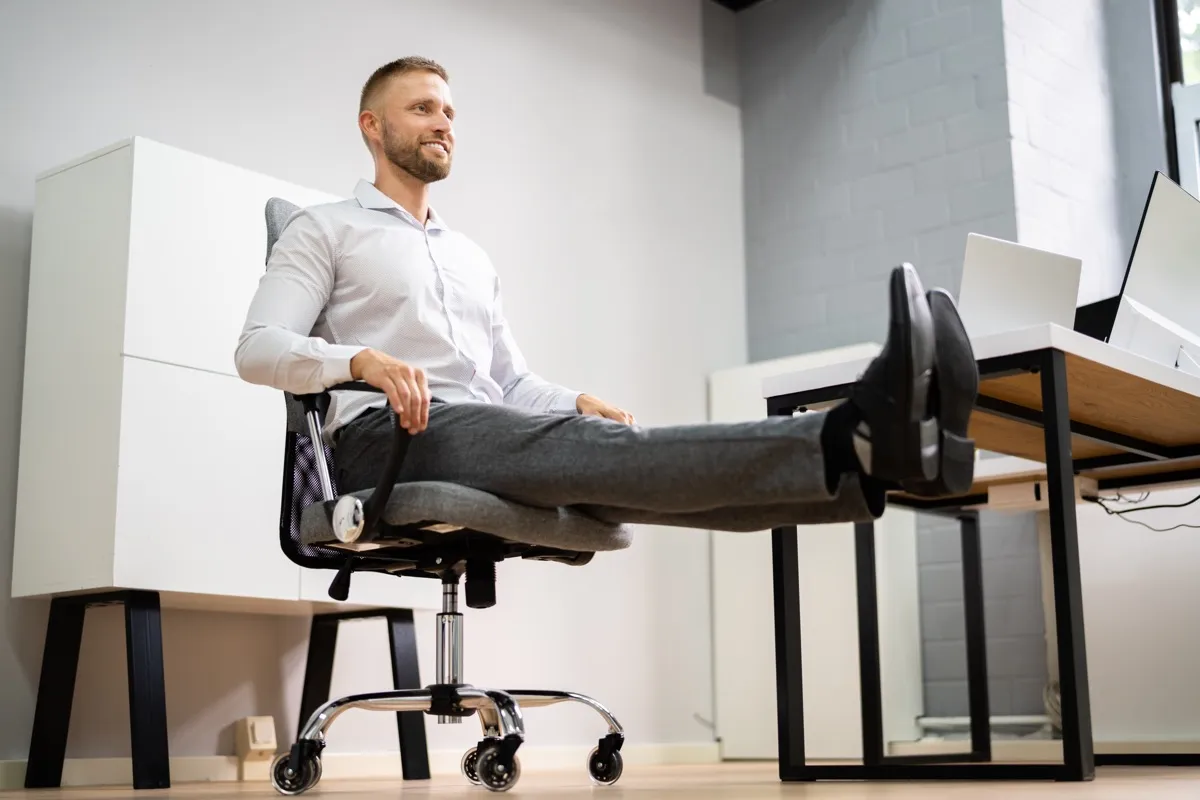
“Tight hamstrings are a common side effect of sitting for extended periods. Over time, this can contribute to discomfort and pain in the lower back and hips, restrict mobility, and affect posture,” White notes.
To stretch this muscle, push your chair away from your desk, straighten one leg in front of you with your heel on the floor and toes pointing upwards, he suggests. Lean forward slightly from your hips until you feel a stretch in the back of your thigh, and hold this pose for about 20 seconds before switching legs.
“The seated hamstring stretch lengthens these muscles, increasing their flexibility and reducing tension,” White explains. “Regular hamstring stretching can help prevent lower back pain, improve your performance in physical activities, and make everyday movements like walking or bending easier.”
Noel Thomas, a physical therapist at FYZICAL, adds that this can also help stretch your calf muscles, which can help prevent adaptive muscle shortening in the lower legs.
RELATED: 9 Easy Ways to Actually Hit 10,000 Steps a Day.
5. Wrist and forearm stretch

You may not notice the tension building in your arms while you work, but White warns that people who spend a lot of time typing are at risk for repetitive strain injuries like carpal tunnel syndrome. He says these can cause pain, numbness, and weakness in the hands and arms.
To stretch your wrist and forearm, he recommends extending one arm in front of you with the palm up. Use your other hand to gently pull the fingers down towards the floor, stretching your wrist and forearm, and hold for about 20 seconds before switching sides.
“Regularly performing this stretch can help prevent discomfort, maintain hand and arm health, and might even improve your typing speed and efficiency,” he tells Best Life.
6. Bear hug
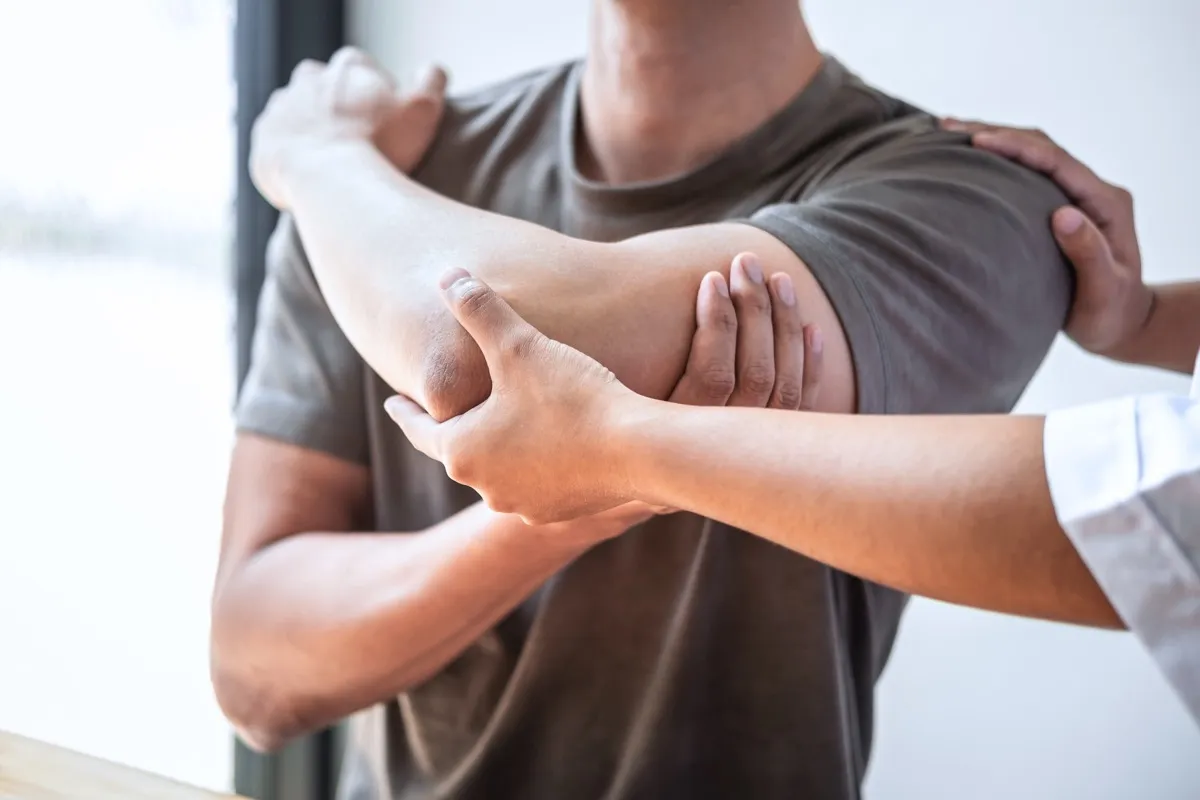
If your upper back aches after a long day at work, you may benefit from giving yourself bear hugs throughout the day, York says. Simply cross your arms over your chest, and hold your opposite shoulder in each hand. Alternatively, you can stretch one arm at a time, applying pressure with your opposite hand.
“This movement will target the muscles in your back,” not to mention release lactic acid and fend off soreness, he tells Best Life.
“Sitting can make it easy to develop poor posture, so regular stretching of this kind can keep you aware of how your body is positioned. Especially as you get older, things start to get tighter so incorporating stretching into your daily routine becomes increasingly important,” he adds.
For more wellness tips sent directly to your inbox, sign up for our daily newsletter.
7. Seated figure 4 stretch
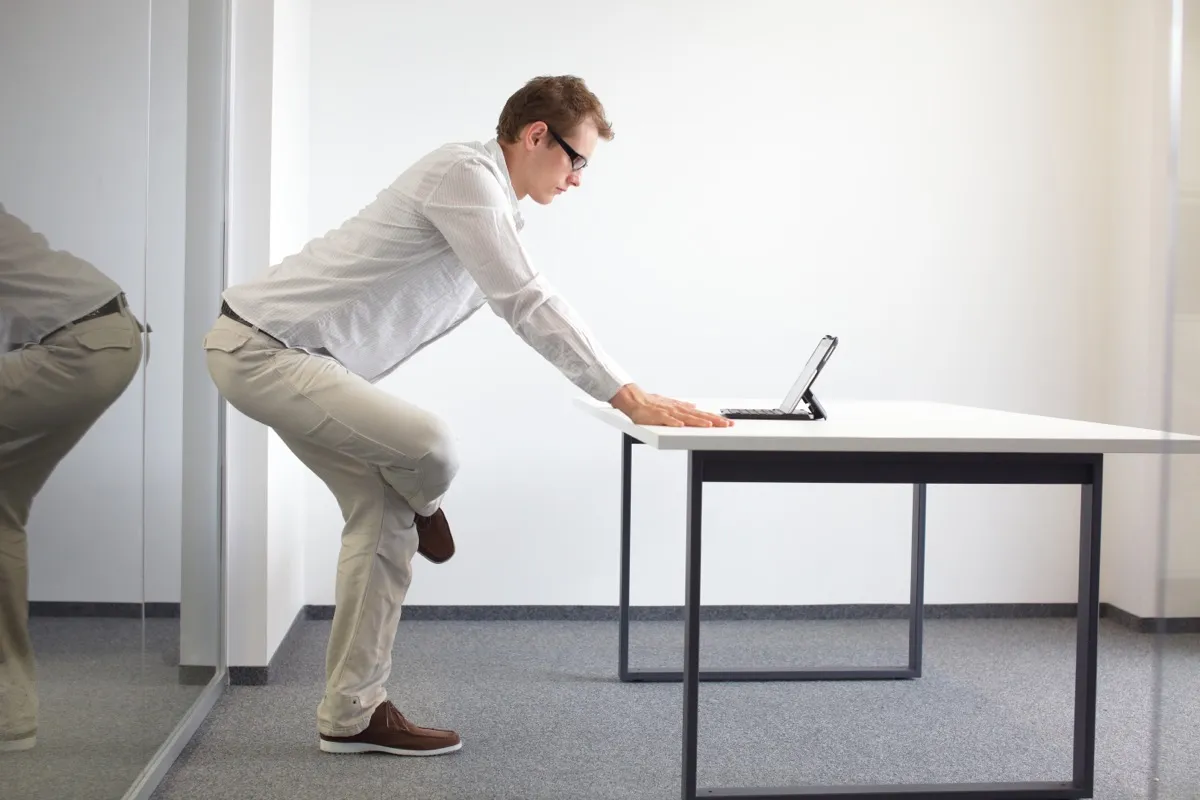
Most often, people do a figure 4 stretch while lying on the ground. However, Lo Santos, a master coach at TITLE Boxing Club, says this stretch can easily be adapted to your desk chair.
Begin by placing your left foot flat on the ground, she says. Then, lay your right ankle across your left knee. From this position, hinge forward over your legs slowly, keeping the spine long. Increase the stretch by pressing your knee open as you stretch forward. “This is a great hip opener!” Santos tells Best Life.
Faris agrees that this is an especially effective stretch in the workplace. “When at your desk, your hips often do not leave the 90-degree angle of a seated position—this stretch can help to create more mobility in your hips and decrease any tension,” she says.